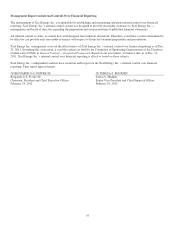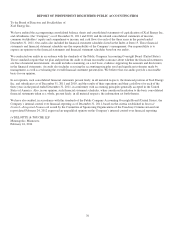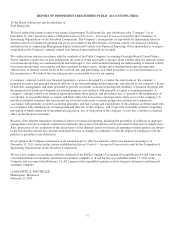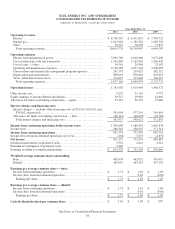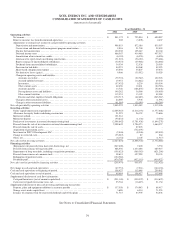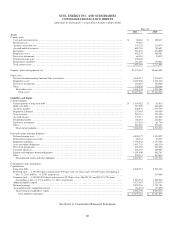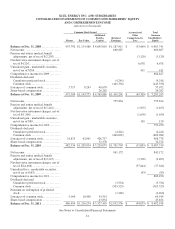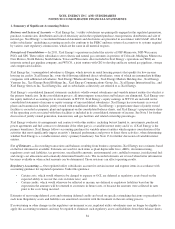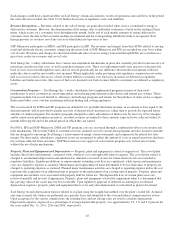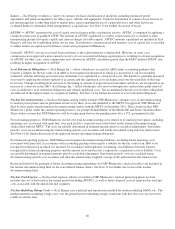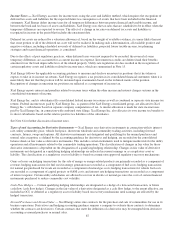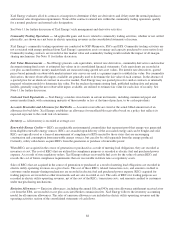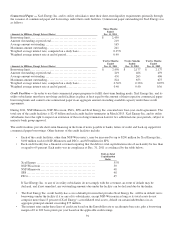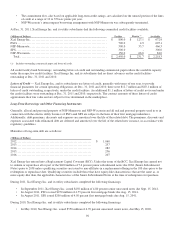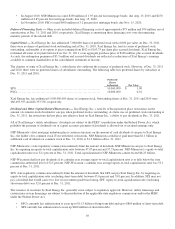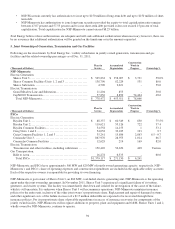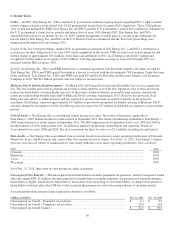Xcel Energy 2011 Annual Report Download - page 95
Download and view the complete annual report
Please find page 95 of the 2011 Xcel Energy annual report below. You can navigate through the pages in the report by either clicking on the pages listed below, or by using the keyword search tool below to find specific information within the annual report.85
Such changes could have a material effect on Xcel Energy’s financial condition, results of operations and cash flows in the period
the write-offs are recorded. See Note 15 for further discussion of regulatory assets and liabilities.
Revenue Recognition — Revenues related to the sale of energy are generally recorded when service is rendered or energy is
delivered to customers. However, the determination of the energy sales to individual customers is based on the reading of their
meter, which occurs on a systematic basis throughout the month. At the end of each month, amounts of energy delivered to
customers since the date of the last meter reading are estimated and the corresponding unbilled revenue is recognized. Xcel
Energy presents its revenues net of any excise or other fiduciary-type taxes or fees.
NSP-Minnesota participates in MISO, and SPS participates in SPP. The revenues and charges from these RTOs related to serving
retail and wholesale electric customers comprising the native load of NSP-Minnesota and SPS are recorded on a net basis within
cost of sales. Revenues and charges for short term wholesale sales of excess energy transacted through RTOs are recorded on a
gross basis in electric revenues and cost of sales.
Xcel Energy Inc.’s utility subsidiaries have various rate-adjustment mechanisms in place that currently provide for the recovery of
natural gas and electric fuel costs, as well as purchased energy costs. These cost-adjustment tariffs may increase or decrease the
level of costs recovered through base rates and are revised periodically for any difference between the total amount collected
under the clauses and the recoverable costs incurred. Where applicable, under governing state regulatory commission rate orders,
fuel cost over-recoveries (the excess of fuel revenue billed to customers over fuel costs incurred) are deferred as regulatory
liabilities and under-recoveries (the excess of fuel costs incurred over fuel revenues billed to customers) are deferred as regulatory
assets.
Conservation Programs — Xcel Energy Inc.’s utility subsidiaries have implemented programs in many of their retail
jurisdictions to assist customers in conserving energy and reducing peak demand on the electric and natural gas systems. These
programs include, but are not limited to, efficiency and redesign programs and rebates for the purchase of items such as compact
fluorescent bulbs, saver switches and energy-efficient heating and cooling appliances.
The costs incurred for DSM and CIP programs are deferred if it is probable that future revenue, in an amount at least equal to the
deferred amount, will be provided to permit recovery of the previously incurred cost, rather than to provide for expected future
amounts of similar programs. For incentive programs designed to allow adjustments of future rates for recovery of lost margins
and/or conservation performance incentives, recorded revenues are limited to those amounts expected to be collected within 24
months following the end of the annual period in which they are earned.
For PSCo, SPS and NSP-Minnesota, DSM and CIP program costs are recovered through a combination of base rate revenue and
rider mechanisms. The revenue billed to customers recovers incurred costs for conservation programs and also incentive amounts
that are designed to encourage Xcel Energy’s achievement of energy conservation goals and compensate for related lost sales
margin. For these utility subsidiaries, regulatory assets are recognized to reflect the amount of costs or earned incentives that have
not yet been collected from customers. NSP-Wisconsin recovers approved conservation program costs in base rate revenue,
without the use of rider mechanisms.
Property, Plant and Equipment and Depreciation — Property, plant and equipment is stated at original cost. The cost of plant
includes direct labor and materials, contracted work, overhead costs and applicable interest expense. The cost of plant retired is
charged to accumulated depreciation and amortization. Amounts recovered in rates for future removal costs are recorded as
regulatory liabilities. Significant additions or improvements extending asset lives are capitalized, while repairs and maintenance
costs are charged to expense as incurred. Maintenance and replacement of items determined to be less than units of property are
charged to operating expenses as incurred. Planned major maintenance activities are charged to operating expense unless the cost
represents the acquisition of an additional unit of property or the replacement of an existing unit of property. Property, plant and
equipment also includes costs associated with property held for future use. The depreciable lives of certain plant assets are
reviewed annually and revised, if appropriate. Property, plant and equipment is tested for impairment when it is determined that
the carrying value of the assets may not be recoverable. Upon regulatory approval of deferred accounting for accelerated
depreciation expenses, property, plant and equipment that is to be early decommissioned is reclassified as plant to be retired.
Xcel Energy records depreciation expense related to its plant using the straight-line method over the plant’s useful life. Actuarial
and semi-actuarial life studies are performed on a periodic basis and submitted to the state and federal commissions for review.
Upon acceptance by the various commissions, the resulting lives and net salvage rates are used to calculate depreciation.
Depreciation expense, expressed as a percentage of average depreciable property, was approximately 2.9, 3.0, and 2.9 percent for
the years ended Dec. 31, 2011, 2010 and 2009, respectively.


